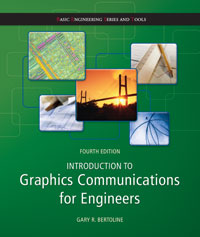 |  Introduction to Graphics Communications for Engineers, 4/e Gary R. Bertoline,
Purdue University
Introduction to Graphics Communications for Engineers, Fourth Edition, is a concise introductory engineering drawing text, intended for use in technical drawing or engineering graphics courses at two- and four-year schools or other technology programs.
Powerful computers and CAD software are of little use to engineers who do not fully understand the fundamentals of graphics communication principles and 3-D modeling strategies, or do not possess a level of visualization ability. Because of this, Bertoline concentrates on the concepts and skills necessary to sketch and create 2-D drawings and 3-D CAD models.Outstanding Features:New! Design Problems were developed to provide students an opportunity to exercise the various stages of the design process. The problems provide an ideation stage, a decision-making stage, design creation stage, and the documentation stage. Each problem includes provisions for sketching, 3-D modeling, and documentation of the student’s final solution to the problem.New! Supplemental Solid Modeling Exercise, new to the fourth edition, focuses on 3-D solid modeling for parts and assemblies. Visual examples for each part and assembly have been created with various solid modeling software packages and are included with engineering sketches to aid students in visualizing part geometry and the modeling process.Design in Industry Boxes, containing some aspect of design from industry, are featured in this edition. Students will learn how design is done in the real world from these interesting stories presented by practicing engineers and technologists.Practice Problems are included throughout each chapter in the fourth edition. These problems give students an opportunity to get drawing practice as they work through concepts.End-Of-Chapter Sketching Problems reinforce what students are learning in the chapter.Student-Friendly Pedagogy includes: a list of objectives at the beginning of chapters, step-by-step instructions on how to draw, and a wide assortment of problems that can be assigned to reinforce concepts.
This book is part of the B.E.S.T. (Basic Engineering Series and Tools), which consists of modularized textbooks offering virtually every topic and specialty likely to be of interest to engineers.
|



 2009 McGraw-Hill Higher Education
2009 McGraw-Hill Higher Education